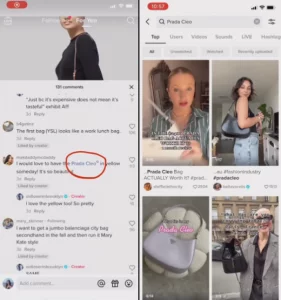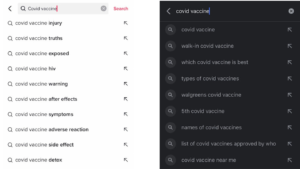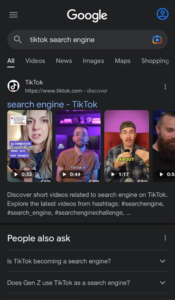
For decades, Google has dominated digital search. However, Generation Z (those born between 1997 and 2012) is ushering in a new competitor, TikTok. The highly visual and personalized discovery tools on TikTok have prompted to use the video-sharing platform as a primary search engine. Additionally, TikTok recently increased the maximum length of its video descriptions and added linked keywords to improve the discoverability of content. Moreover, TikTok’s growing popularity for finding information signals a broader shift in digital search. Read on to learn more about TikTok’s search features and implications for digital search.
TikTok as A Search Engine
TikTok provides audiences with user-generated videos related to their search queries and customized to each person’s unique viewing preferences. As The New York Times reported, Gen Z prefers the dynamic, personalized video recommendations provided by TikTok compared to the more generic, text-heavy results from Google.
In addition to searching for products or businesses on TikTok, Gen Z also looks up “how-to” content and explanations for queries once typed into Google. The report elaborates that Gen Z-ers determine the value of a video suggestion for their search query based on the comments left on the post.
Furthermore, according to Business Wire, 79% of consumers say user-generated content significantly affects their purchasing decisions. This holds especially true for Gen Z based on their preference for finding information via user-generated videos on TikTok.
Improving Content Discoverability on TikTok
To enhance its search offerings, TikTok has increased the maximum length of video descriptions and introduced linked keywords. Previously, TikTok video descriptions were limited to 300 characters. However, recognizing the opportunity to improve the searchability of user-generated content, TikTok expanded the limit to 2,200. This allows for more details and keywords to be incorporated into descriptions to boost the content’s discoverability.
Further, including linked keywords in comments and video descriptions serve to send users to the app’s discovery page. In effect, audiences spend more time on TikTok as they scroll through new content linked to the keywords.
Elsewhere, in Southeast Asia, TikTok is testing a local content feed so users can search for businesses and events near them. These updates and new features demonstrate TikTok’s intentions to become a major player in digital search.
Image via Social Media Today
Concerns about Using TikTok as a Search Engine
With floods of content being uploaded to TikTok every day, the potential for sourcing and spreading misinformation or disinformation is a concern for using TikTok as a search engine. In addition, the app is already facing scrutiny for its unsatisfactory content moderation related to the Russia-Ukraine conflict and abortion, among other news topics.
In a recent study by NewsGuard, nearly 20% of search results on TikTok included misinformation. Further, the study reports that the app suggests biased search terms, whereas Google provides more neutral search terms.
With features designed to keep users on the app as long as possible, people are less likely to turn to sources outside TikTok. So, fact-checking becomes less likely, and the risk of spreading misinformation or disinformation increases.
Image via NewsGuard
The Future of Digital Search
Search engines like Google revolutionized access to information via online searches. Today, Gen Z’s visual search preferences and TikTok’s user-generated content set a new precedent for digital search. This evolution seems to have influenced Google to reimagine its search offerings and provide a more visual search experience.
Several months ago, Google began indexing TikTok and Instagram videos in its search results. But as TikTok continues to rise in the ranks of digital search, Google is already re-engineering its search results, shifting to a visual-first format. For instance, Google is updating its informational boxes, referred to as “Knowledge Panels,” to include colorful media and imagery.
At Google’s “Search On 2022” event, the tech giant discussed its plans to make visual search “more natural and intuitive” with new features like multisearch and leveraging artificial intelligence for immersive experiences.
With multisearch, images and text can be used simultaneously to find information. At present, multisearch is in beta testing in the U.S.
Another way the tech giant is evolving visual search is with an update to Google Lens, an image recognition technology that uses Generative Adversarial Networks (GANs). This machine-learning technology blends translated text into background images to “break down language barriers.”
As demonstrated by younger generations’ preference for visual, user-generated content and more venues for visual search, digital search is expected to continue prioritizing visual-first formats.
Not sure how to optimize TikTok and SEO? Contact Overdrive Interactive to speak with one of our marketing experts on how we can enhance your SEO strategies.







